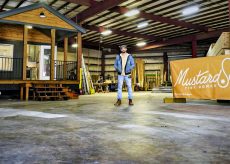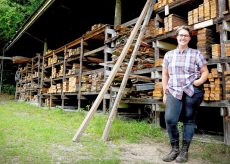Jillian Cooke, Wellness Within Your Walls set to go broad with unique view of wellness

It didn’t take Jillian Pritchard Cooke long to get down to business.
The cancer-survivor and founder of Wellness Within Your Walls, an advocacy group focused on sustainability and healthful living practices, is not one to hold back.
“So, this morning,” I had told her, “I grabbed a wadded-up shirt out of a pile and soaked it with wrinkle releaser. I’m guessing I shouldn’t have done that … ?”
She didn’t hold back.
“It’s not good when we take something that is perfectly fine like natural linen and spray it down with static guard and with wrinkle-resistant and with water proofing,” Pritchard Cooke said with just a hint of pity in her voice. “We take something that might be inherently good and move it into an area we have to exercise responsibility.”
Sufficiently chastised, I meekly listened to her list about a dozen names of products many of you doubtless have under your sink, in your laundry room or shelved in the garage. She asked that I not use their proper nouns because to name just a few would unfairly finger brands that are really no more culpable than most others in the matter of making our world a cleaner but also a potentially more deadly place to live.
“Most people don’t understand what’s in the products owing to a lack of labeling, lack of transparency, lack of off-gassing guidelines,” she said, “and we provide all of those.”
Pritchard Cooke’s vision, and the one that is the raison d’être of her growing organization, is to help everyone engaged in the process of building, maintaining and occupying homes understand how to make life not just move survivable but also more livable. (This story shares more of Pritchard Cooke’s background and that of WWYW.)
“When we speak to energy efficiency and health, both nurturer and breadwinner are both involved in the decisions.”
The organization originally comprised only women because she believed the aim of WWYW was at women, who are typically (though certainly not always, she stressed) the nurturing side of most domestic arrangements. Over the years, the membership of her board became more diverse, and now the sexes are represented equally.
“Targeting the nurturer in the home brings about the conversations, and when we target the bread winner in the home—again, it could be the male or female or both—often that’s when cost-effectiveness comes into play in the conversation,” she said, “and when we speak to energy efficiency and health, both nurturer and breadwinner are both involved in the decisions.”
About 14 years ago, fighting cancer, Pritchard Cooke began to try to comprehend the complex stew of chemical components and environmental factors comprising the modern world. While the building and appliance industries had begun to make great strides owing to market pressures toward sustainability, she found not only myriad factors that had yet even to be acknowledged, but also some alarming consequences of one nascent building practice in particular: the ever-tightening envelope of the modern home.
“As far as consumers go, we haven’t even really scratched the surface. They’ve heard a lot about sustainability and a lot about air efficiency,” she said, but an unfortunate consequence is that in areas without appropriate codes concerning ventilation, the air inside becomes less subject to conditioning but more prone to trapping toxins.
That’s just part of one topic in WWYW’s approach to 360-degree healthy living.
To get a sense of that WWYW, imagine with four columns, one for each category of certification, and rows which represent the 10 life-areas that are addressed by its trademarked Healthy Living System.
The four P’s
The candidates where WWYL offers certification are products, people, places and programs. She calls these the four P’s. Her education events are conducted in two facilities in the Atlanta area and sometimes occur at tradeshows or other home-building industry events. She also has a broad undertaking making its debut later this year with Hearst Publications, one outcome of which will be the sharing of lists of the best—that is, the least toxic while most effective—products on the market. Certification is granted on an entity-by-entity basis. The second is House Beautiful in New York, which will be one of the first Wellness in Walls-certified homes in the United States. Other projects are in the works.
The Healthy Living System: 10 areas where to be mindful
WWYL believes there are 10 components to be examined thoroughly in terms of living well. She goes so far as to say one cannot “Achieve the highest level of wellness without the 10. Some groups only use fewer. We believe people have to practice all 10 on a 24/7 basis.”
- Clean air: Analyze, purify and breathe.
- Clean water. Analyze, purify and hydrate.
- Natural light. Expose, capture and absorb.
- Chemical control. Analyze, remove and contain.
- Physical wellness. Educate, motivate and maintain.
- Spiritual wellness. Reflect, awaken and flourish.
- Mental wellness. Educate, nurture and thrive.
- Conscious consumption. Reduce, reuse and invent.
- Food science. Educate, innovate and provision.
- Behavioral strategies. Contemplate, adapt and maintain.
Ultimately, she said, the System is a “pushback against the industry that’s decided to compartmentalize. And you can’t look at total wellness without looking at these things holistically.”
One example she provided described a home where the owners had done everything possible to create a healthful living environment. But if one of the occupants undergoes surgery and after leaves his narcotic pain relievers around so that another of the family members gains access to them and becomes addicted, all the other work was in essence rendered moot owing to a failure of a behavioral strategy: keep unsafe medications stored in secure locations.



